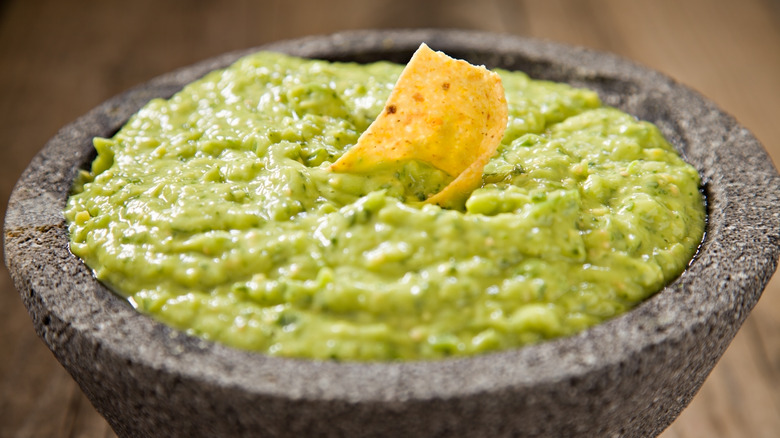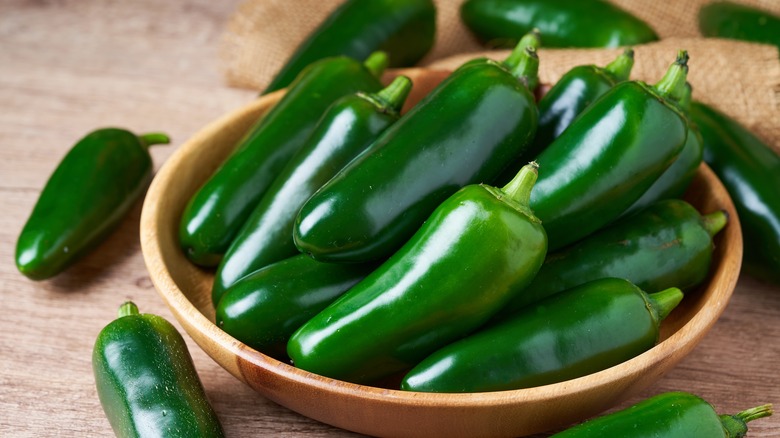Guacachile Is The Perfect Guacamole Substitute When You're Low On Avocados
Timing is key when it comes to guacamole. It always seems like avocados are too firm and need to be ripened, and then in an instant, they're overly mushy. If you're craving guacamole but don't want to depend on avocados, consider a condiment called guacachile. Despite the name, guacachile actually does not contain any avocado. This vibrant green salsa is a simple mix of blended jalapeño peppers, onions, vegetable oil, and salt. Sometimes referred to as "fake guacamole", it's a great option if you're low on avocados, or want to use more affordable ingredients.
If you've ever eaten at a taqueria and spooned a creamy green salsa on top of your taco thinking it was made from avocados, it was probably guacachile. It's a surprisingly silky condiment with color that easily convinces your brain that avocado is clearly the main ingredient. It's also thinner than guacamole or actual avocado-based salsa, making it easier to drizzle atop food like tacos and tostadas. In general, this salsa is considered to be medium-spicy, but the spice levels vary depending on whether the pepper seeds and white pith are also blended in.
History of guacachile
It is believed that guacachile originated in Oaxaca, a southern state in Mexico home to an incredible diversity of chiles. Similarly to guacamole, the word guacachile has Nahuatl origins, the language spoken by the Aztecs; ahuacamolli is the Nahuatl word for guacamole (translating to "avocado sauce"). While guacamole's origins can be traced back hundreds of years to pre-Hispanic times in Mesoamerica, guacachile is a more modern creation. The timing of when, exactly, this salsa emerged is unclear, but it is thought that its creation was a response to the rising price of avocados: In 2009, there was a sharp price increase in avocados due to one of the smallest yields in about 20 years.
Mexican restaurants and taquerias often offer salsa for free alongside chips or food. But avocados are expensive, so using them to make a salsa and not charging for it is not the most economical choice for restaurants. Therefore, guacachile is not necessarily a method of tricking customers, but one of the only viable options for restaurants to continue providing free salsa. Now, it is commonplace to find guacachile throughout taquerias, taco stands, and Mexican restaurants in Mexico and the United States.
Tacos are the most popular food pairing with guacachile, and it's a great complement to many Mexican dishes like sopes, quesadillas, or chilaquiles. The smooth, spicy salsa also works really well on grilled foods, like vegetables and burgers. Or, try it as a dip for fried foods, like taquitos, fried empanadas, and french fries.
Variations of guacachile
Like most salsas and guacamole, there is a lot of room for variations in the standard guacachile. First, consider the spice level. Jalapeños are relatively mild peppers, so you'll get a little kick if these are the base of the guacachile. To turn up the spice and keep the vibrant green color, try using serrano peppers, which are between two and five times hotter than jalapeños. Or, use half jalapeño and half serrano for a medium heat level, depending on your spice tolerance.
A common addition to guacachile in Mexico is zucchini; white zucchini is commonly used in Mexico, but green is also fine. The zucchini is boiled or sauteed, and then blended with the other ingredients to provide a thicker, creamy texture. The addition of ingredients like cilantro (use the stems for a stronger flavor) and lime can enhance the fresh, cool flavors of the salsa, as you would find in guacamole. Tomatillos can also be added to make the texture a little closer to a classic salsa verde.
Vegetable oil is normally used in guacachile due to its neutral flavor, but avocado oil or olive oil could be used. Fresh avocado oil will mostly maintain the neutral flavor with a touch of nuttiness, while olive oil will add grassy notes.


